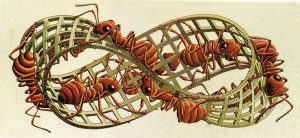WIDE IMAGE

1) The Writing of the Disaster. In Konsult egents articulate or reoccupy (retrieve) the conventions of microcosm/macrocosm by which pre-modern peoples oriented themselves (determined their EPS): As above, so below (one’s fate was written in the stars, and to read it one consulted oracles and astrologers). A contemporary version shifts from vertical to horizontal dynamics: As without, so within, The historical collective and the individual person become mutually intelligible when articulated in the proportional analogy of hypotyposis (The Writing of the Disaster/In Me). Such is the conceit of this genre organizing pedagogy in the digital apparatus. The guiding idea of Project #1 (heuretics of Konsult) is an encounter between egents and disaster, in which egents translate their image of wide scope (Wide Image) into a diagram, to function as an original hypothesis addressing the impasse (aporia) of Disaster.
–Mystory. In order to undertake Project #1, egents first must engage the nested Project #2, Mystory. Mystory is a genre for finding/designing an Image of Wide Scope (Wide Image; WI). We will devote considerable attention to this genre, which is the core of electrate pedagogy. The first insight is that electracy does not shift the disciplinary curriculum of literacy but rather the pedagogy. The rationale for this shift comes from Gerald Holton, history of science, argued in such books as Thematic Origins of Scientific Thought: Kepler to Einstein (Harvard, 1988). Holton notes that the practice of science (and all productive knowing) includes three primary dimensions, of which two are routinely taught while third remains latent, implicit. Discipline learning is organized around verification (knowledge after it is discovered or invented): making as techne, which is considered to be teachable. Techne as practice includes empirical facts (materially tested); and analytical tools. The third dimension (not taught or considered not teachable) also operates nonetheless, Holton insists. It is the dimension of discovery, creativity, which Holton calls thematic– making as poiesis. The empirical and analytical are objectively present in the disciplinary institution; the thematic is subjectively personal to the egent. Its origin is one’s disposition, a unique mix of nature and nurture, referring to one’s state of mind or attunement, attitude. Holton approaches the history of science from the side of themata, existing as archetypes in the history of thought and patterns of imagination specific to individuals. They are not provable, but are the source of hypotheses. Here is a key: Disposition generates original hypothesis.

–From Disposition to Hypothesis. The first lesson from Holton is to track this relation between disposition and hypothesis, since it establishes exactly the place of the Arts and Letters archive in electrate pedagogy as creativity. The insight to register for now is that disposition is precisely the concern of much of Philosophy, especially Continental thought, as in Heidegger’s question of how things stand with me, with us, Dasein (there-being) and Ereignis (collective enowning of event). Underlying Existential Positioning Systems is Existential Phenomenology, for example. The import for curriculum is that inquiry into disposition draws upon the traditions of Philosophy. The Image of Wide Scope designed through mystory puts into form and brings to expression egent’s disposition. Similarly, the best resource for learning how to formulate and translate this disposition into hypothesis is through study of literature (transmedia). The authority here is Northrop Frye, who in Anatomy of Criticism stated that literature and fiction as such are hypothetical. In short, this thematic dimension of science (of knowing) opens onto the Humanities (Arts and Letters) disciplines, locating the frontier articulating “the two cultures.”
–Albert Camus, Lyrical Essays. Holton observed in his study of revolutionary science that the work of individual creators manifested a pattern organized around a few (four to five) images (the Wide Image). Albert Camus anticipated this insight in reflecting on his own career, commenting on the reissue of his early collection of essays, The Wrong Side and the Right Side, which serves as an epigraph for mystory.
Nothing prevents one from dreaming, in the very hour of exile, since at least I know this, with sure and certain knowledge: a man’s work is nothing but this slow trek to rediscover, through the detours of art, those two or three great and simple images in whose presence his heart first opened. This is why, perhaps, after working and producing for twenty years, I still live with the idea that my work has not even begun. (Albert Camus, Lyrical and Critical Essays, 17).
